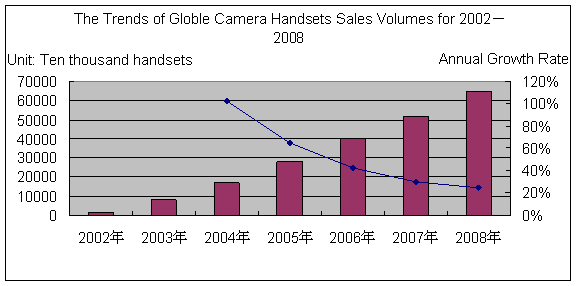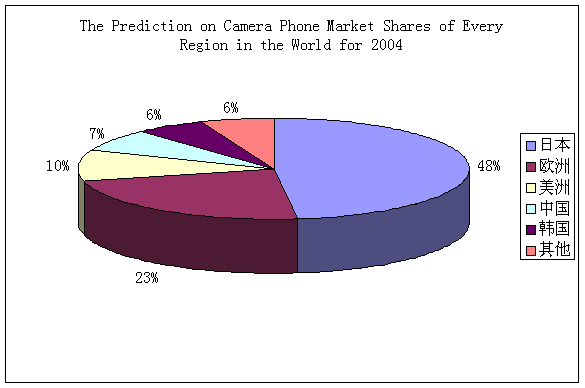|
Summary
|
Forewords
In other to have a comprehensive perspective into the competition
landscape of global camera handset market and the relationship
of supply-chains;understand the key technologies and market developments
for Camera Phones; analyse the cooperative relationship between
the upstream vendors and downstream vendors in camera phone industry
and the market performance; gain a insight into the opportunities
in global camera phone market and know about the demands conditions
for camera phones from the consumers; Pday Research has dug out
deeply the informations and data related with more than a hundred
of enterprises in camera industry and translated the reports and
articles concerned; and finally compiled General Research Analysis
on Camera Phones Industry for 2004 through collection, analysis
and researches, which has more than 200 pages for the whole text,
and contains more than 200 charts and tables。
Source:Strategy Analytics,InfoTrends,Collected by PdayResearch
2004.06

Source: Strategy Analytics,InfoTrends,Collected by PdayResearch,
2004.06

Summary
According to the statistics, the annual sales volume of camera
phones reached 84 million handsets for 2003, increased almost
five times than 18 million handsets of 2002, accounting for 16%
of the total sales volum of goldal handsets, and expected to reach
170 million handsets for 2004, double times of that for last year.
In 2003, there were about 6.5 million camera phones sold in China's
market, increased 528% against last year. The sales of camera
phones is expected to reach 1.176 million handsets for 2004, a
increase of 80% against last year, accounting for 12% of the total
sales of domestic handset market.
The sales market of camera phones is very promising all the way,
which is mainly thanks to the powerful function of the camera
phone for amusement. As the handset is a portable communication
tools, the convenience of a camera phonen is far beyond the digital
camera. For the past two years, although the pixels of camera
phones are not satisfactory, the camera phones have been widely
recognized from the consumers.
The factors that further promote the spreading of the camera
phones also include the following aspects:
- More and more new brands, intensified competition, the constant
price decrease of the camera phones
- The price of the camera phones at middle grade equals to that
of household digital camera, camera phones take shares from
the market of household digital cameras.
- The operators and providers of contents have been actively
introducing value added services based on camera phones and
further help the prosperity of camera phones.
All the majar vendors have increased the input for camera phone.
At the end of 2003, Motorola launched 8 new built-in camera phones
in a row. Meanwhile, Nokia announced that the new handsets launched
later on will all contain the video. Japan's NEC is the largest
camera phone provider in the world, occupied 16% of the global
camera phone marke shares of 2003, and above 90% of its shipment
of handsets for the last yeat featured camera moudles.
Camera phone constantly strives for high pixels
The camera phones that were newly launched in 2004 reached the
level of million pixels in general. For Panda, SED, Bird, Amoi,
the camera phones with million pixels have already been or wll
be launched in 2004. TCL also announced that the camera phones
with 3 million pixels will be launched by the end of 2004.
If the camera phones reach the level of 2 million pixels, its
picture quality is close to that of the film for analog cameras,
and thus can statisfied the ordinary demands from the consumers.The
Variable Focal Lenses with 2 million pixels is the mainstay for
household cameras. The camera phones with these two technical
indices have been on the market, SharpSH505iS, SharpSH900i, Nokia7610,
Samsung SPH-V4400,are all the camera phones with 2 million pixeks.
For leading the trends of handsets markets, the vendors from
Japan, Europe and South Korea have formed a situation of tripartite
confrontation. In May 2004, CASIO launched the world's first camera
phone with focus lens and 3 million pixels. In the early July,
South Korea's Samsung launched the world's second camera phone
with focus lens and 3 million pixels. Moreover, Samsung is now
striving to deliver a camera phone with 5 million pixels as soon
as possible.
By the early July 2004, the release status of global camera phones
with million pixels are as follows:
|
Vendors from Japan
|
Vendors from Europe
|
Vendors
from South
Korea
|
|
SonyEricssonS700:1.3 million pixels
SonyEricssonA5404S:1.3 million pixels
SonyEricssonSO505i:1.3 million pixels
SonyEricssonSO505iS:1.3 million pixels
PanasonicP505iS:1.28 million pixels
FujitsuF900i:1.3 million pixels
kyocera A5502K:1 million pixels
SharpSH505iS:2.02 million pixels
SharpSH900i:2.02 million pixels
Mitsubishi.D505iS:1 million pixels
卡西欧A5406CA:3 million pixels
|
Nokia7610:2.02 million pixels
MotorolaA1000:1.2 million pixels
MotorolaA840:1.2 million pixels
MotorolaV710:1.2 million pixels
Siemens
S65:1.3 million pixels
|
LG T5100:
1.3
million pixels
Samsung
P730:
1
million pixels
Samsung
SCH-V420:
1.3
million pixels
Samsung
SPH-V4400:
2
million pixels
Samsung
SPH-2300:
3
million pixels
LG
SD350
3
million pixels
LG
KP-3500
3
million pixels
PH
K1000V
3
million pixels
|
|
contents |
Chapter one: Analysis on the current condition and development
trends of camera phone industry
1.1 Analysis on the current conditions of camera phones industry.
1.1.1 Overview of camera phone industry
1.1.2 The formation of camera phone industry
1.1.3 The current conditions of camera phone industry
1.2 Analysis on the development trends of camera phone industry
1.2.1 The cameras for handset and the digital cameras
1.2.2 The anhlysis on the tendency of the cameras for handsets
Chapter Two: Vendors for core accessories
2.1 Overbiew of the market for lens modules
2.2 Vendors for lens modules
2.2.1 台湾大立光
2.2.2 台湾亚光
2.2.3 台湾今国光
2.2.4 台湾晶远
2.2.5 台湾玉晶
2.2.6 Philips
2.2.7 Olympus
2.2.8 Samsung Electro-Mechanics
……
2.3 Overview of transducers
2.4 Vendors of CMOS modules
2.4.1 锐相(IC Media)
2.4.2 原相(Pixart)
2.4.3 泰视(TASC)
2.4.4 宜霖(ElecVision)
2.4.5 Agilent
2.4.6 Omnivision
2.4.7 意法半导体
2.4.8 Micron
2.4.9 TransChip
2.4.10 Conexant
2.4.11 Hynix
……
2.5 Vendors of CCD modules
2.5.1 Sanyo
2.5.2 Sharp
2.5.3 fuji
2.5.4 Panasonic
2.5.5 Sony
……
2.6 Overview of back-end image processing IC market
2.7 Vendors of back-end image processing IC
2.7.1 TI
2.7.2 Qualcomm.
2.7.3 瑞萨
2.7.4 中星微电子
……
2.8 Overview of camera modules markets
2.9 Vendors of camera modules
2.9.1 台湾群光电子
2.9.2 普立尔科技
2.9.3 致伸科技
2.9.4 智基电子
2.9.5 敦南科技
2.9.6 Cowell World Optech
2.9.7 Sunyang Digital Image
2.9.8 Techwin
……
Chapter three: Analysis on camera phone manufacturers
3.1 Nokia
3.2 Motorola
3.3 SonyEricsson
3.4 Siemens
3.5 Philips
3.6 Alcatel
3.7 Lucent
3.8 LG
3.9 Samsung
3.10 Panasonic
3.11 NEC
3.12 Mitsubishi.
3.13 kyocera
3.14 Sanyo
……
3.29 SED
3.30 Capitel
3.31 托普
3.32 Panda
3.33 Amoi
3.34 Chabridge
3.35 ZTE
3.36 OKWAP
Chapter four: Analysis on consumption and application of camera
phones
4.1 Overview of camera phones applications
4.2 Analysis on the demands for camera phone from consumers
4.3 Analysis on the demands for camera phones from operators and
content providers
4.4 Analysis on the opportunities resulted from camera phones
to the manufacturers
Chapter Five: Analysis on global camera handsets market
5.1 Analysis on Japan's camera phones market
5.2 Analysis on Europe's camera phones market
5.3 Analysis on the camera phones market in Taiwan of China
5.4 Analysis on the camera phones market in mainland of China
Chapter Six: Conclusions and suggestions
6.1 Conclusions and suggestions on core accessoty vendors
6.2 Conclusions and suggestions on the manufacturers for assembled
camera phones
6.3 Conclusions and suggestions on operators and content providers
|




